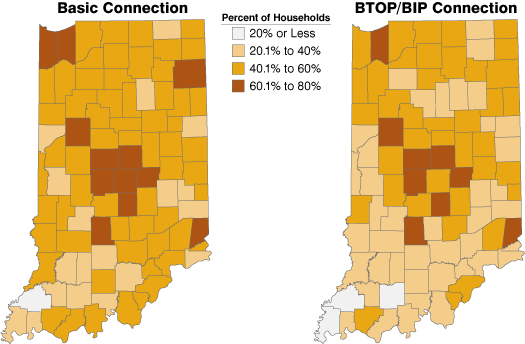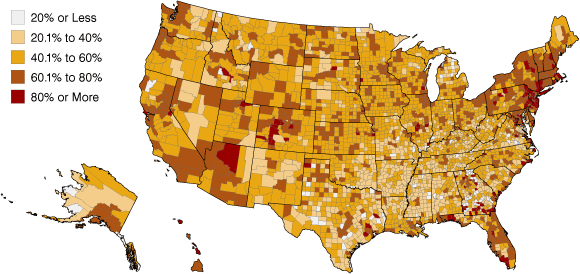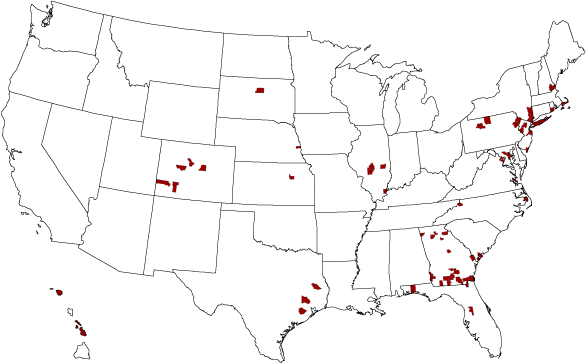Broadband Adoption in Indiana
The link between high-speed Internet connections and economic development has become more pronounced in recent years. The Brookings Institution has gone so far as to estimate that for every 1 percentage point increase in broadband penetration in a state, nonfarm private employment is projected to increase by 0.2 to 0.3 percent.1 While the rate of broadband adoption has slowed in recent years (partly due to the recession), two-thirds of American adults now use a high-speed Internet connection at home,2 and Congress has tasked the Federal Communications Commission (FCC) with developing a plan to ensure that every American has access to high-speed capability.3
As part of that national broadband plan, the Indiana Geographic Information Office is in the midst of a multi-year, multi-agency effort to map where broadband coverage exists across the state (down to the census block level).4 While the vast majority of the state has access to broadband capability, how many Hoosier households are actually adopting this technology?
In the past two years, the FCC began tracking residential broadband adoption at the census tract and county level.5 The agency looks at two definitions of broadband:
- Basic broadband: Residential fixed connections with a minimum of 200 kilobits per second (Kbps) in at least one direction. This is an old standard adopted by the FCC back in 1999.
- The BTOP/BIP definition: Residential fixed connections with at least 768 Kbps downstream (i.e., downloading files from the Internet to your computer) and greater than 200 Kbps upstream (i.e., uploading files from your computer to the Internet). This is the definition used by the National Telecommunications and Information Administration.
To provide some context for the non-technical among us, even though the BTOP/BIP definition is faster than the bare minimum, it is still encompassing the slower end of broadband since the U.S. average broadband speed is 5 megabits per second (Mbps) as of the third quarter of 2010. (As an aside, South Korea leads the world with an average connection speed of 14 Mbps.)6 So even though the high-speed Internet access definitions used by the FCC are rather broad, this data set enables us to look at broadband adoption rates for specific geographies across the state and nation.
How Do Indiana Counties Fare?
Figure 1 shows adoption rates for both broadband definitions by Indiana county as of December 2009. Looking at basic broadband service, 12 of Indiana’s 92 counties have between 60 and 80 percent of households with high-speed Internet access. Using the BTOP/BIP definition, that number drops to 9 Indiana counties.
Figure 1: Broadband Adoption by Indiana County, December 2009

Source: IBRC, using FCC data
When one looks at southwest Indiana, Evansville is notable among the state’s metros for its low rates of broadband adoption. According to the FCC, Gibson County is the only county in the state where 20 percent or less of its households have basic broadband access. When looking at the faster BTOP/BIP definition, Gibson and Posey counties have adoption rates of 20 percent or less, while Vanderburgh County has adoption rates of 40 percent or less.
The ability to look at change between December 2008 and December 2009 is limited: the FCC only reports data in ranges rather than an actual number of connections in each county. Using the BTOP/BIP definition, four Indiana counties (Gibson, Dubois, Posey and Vanderburgh ) saw their percentage of households with broadband decline by a category, while 35 counties increased by a category.
Leaders in Broadband Adoption Nationally
Figure 2 shows 2009 basic broadband adoption across the nation. In 120 counties (none of which were in Indiana), more than 80 percent of households had a broadband connection.
Figure 2: Basic Broadband Adoption by U.S. County, December 2009

Source: IBRC, using FCC data
When looking at the BTOP/BIP definition of broadband nationwide, 66 counties had adoption rates exceeding 80 percent of households (see Figure 3).
Figure 3: Counties Where More than 80 Percent of Households Have a BTOP/BIP Broadband Connection, December 2009

Source: IBRC, using FCC data
Summary
While in past decades access to interstates and railroads played a crucial role in economic development, the knowledge-based economy is experiencing a similar reliance on broadband connectivity. These data from the FCC show that broadband adoption rates tend to be lower in southern Indiana relative to the rest of the state, making this an indicator for economic developers to watch as time goes on.
To learn more about the National Broadband Plan, visit https://transition.fcc.gov/national-broadband-plan/national-broadband-plan.pdf.
Notes
- Robert W. Crandall, Robert E. Litan and William Lehr, “The Effects of Broadband Deployment on Output and Employment: A Cross-Sectional Analysis of U.S. Data,” Issues in Economic Policy, no. 6, July 2007, www.brookings.edu/research/the-effects-of-broadband-deployment-on-output-and-employment-a-cross-sectional-analysis-of-u-s-data/.
- Aaron Smith, “Home Broadband 2010,” Pew Internet & American Life Project, August 11, 2010, https://www.pewresearch.org/internet/2010/08/11/home-broadband-2010/.
- “National Broadband Plan Executive Summary,” Broadband.gov, https://transition.fcc.gov/national-broadband-plan/national-broadband-plan-executive-summary.pdf.
- For more information about this initiative and broadband availability maps, visit www.indianabroadbandmap.com/.
- This data set, “Census tract information mapped for Internet access services faster than 200 kbps in at least one direction,” is available at www.fcc.gov/wcb/iatd/comp.html.
- Akamai Technologies, “The State of the Internet 3rd Quarter, 2010 Report,” www.akamai.com/stateoftheinternet/.
Rachel Justis
Geodemographic Analyst, Indiana Business Research Center, Indiana University Kelley School of Business
